Satas D., Tracton A.A. (ed.). Coatings Technology Handbook
Подождите немного. Документ загружается.

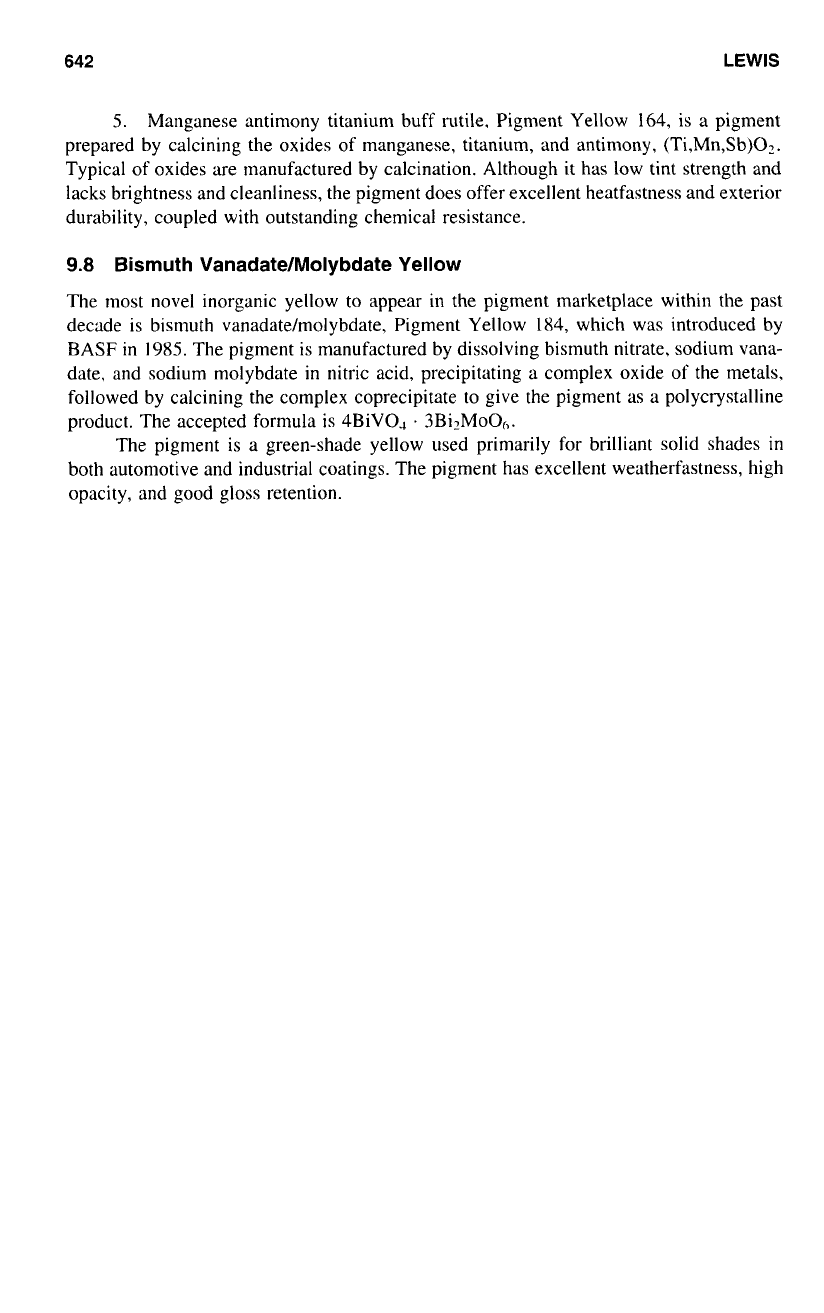
642
LEWIS
5.
Manganese antimony titanium buff rutile. Pigment Yellow
164,
is a pigment
prepared by calcining the oxides of manganese, titanium, and antimony, (Ti,Mn,Sb)O?.
Typical
of
oxides are manufactured by calcination. Although it has low tint strength and
lacks brightness and cleanliness, the pigment does offer excellent heatfastness and exterior
durability, coupled with outstanding chemical resistance.
9.8
Bismuth Vanadate/Molybdate Yellow
The most novel inorganic yellow
to
appear in the pigment marketplace within the past
decade is bismuth vanadate/molybdate, Pigment Yellow
184,
which was introduced by
BASF
in
1985.
The pigment is manufactured by dissolving bismuth nitrate, sodium vana-
date, and sodium molybdate
in
nitric acid, precipitating a complex oxide of the metals,
followed by calcining the complex coprecipitate to give the pigment as a polycrystalline
product. The accepted formula
is
4BiV04
.
3Bi2MoOf,.
The pigment is a green-shade yellow used primarily for brilliant solid shades in
both automotive and industrial coatings. The pigment has excellent weatherfastness, high
opacity, and good gloss retention.
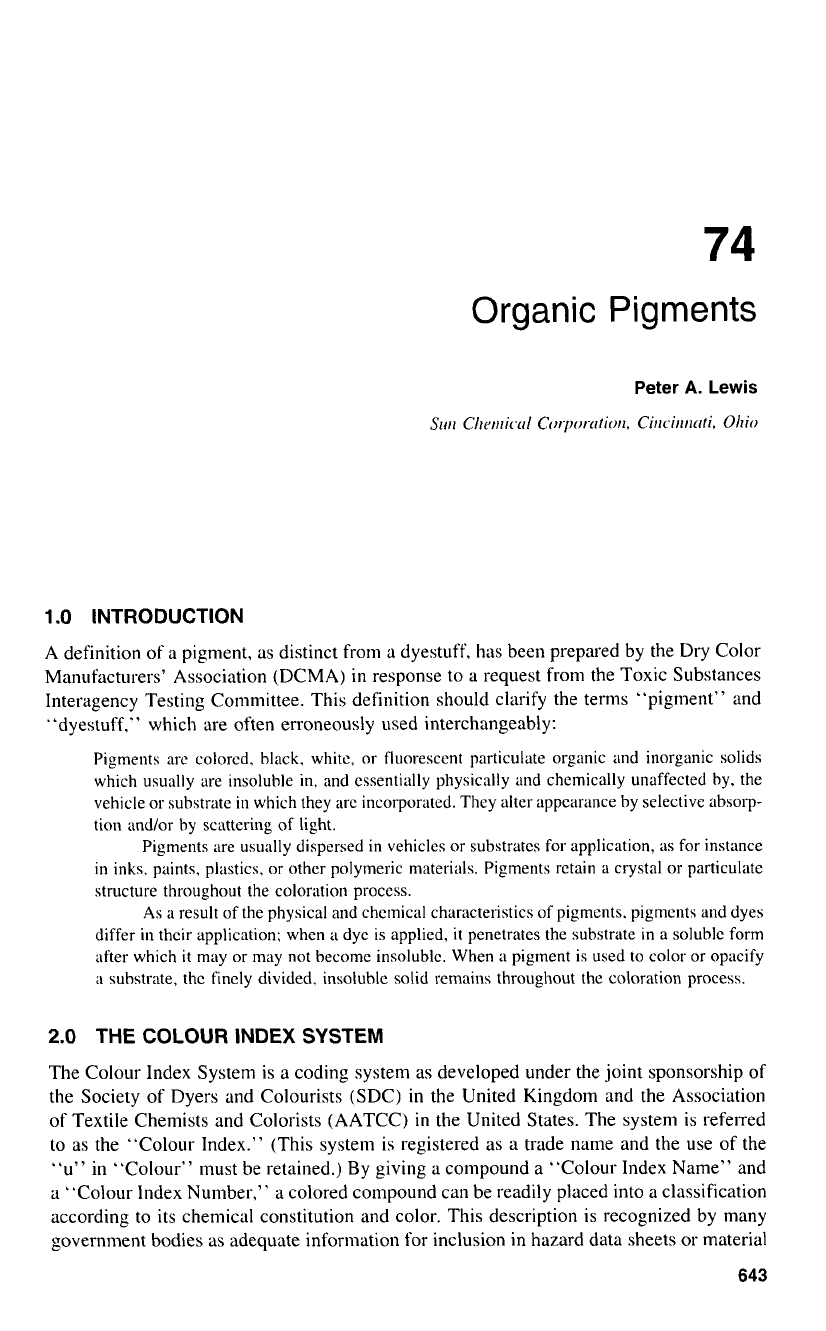
74
Organic Pigments
1
.O
INTRODUCTION
A definition of a pigment, as distinct from a dyestuff. has been prepared by the Dry Color
Manufacturers’ Association (DCMA)
in
response
to
a request from the Toxic Substances
Interagency Testing Committee. This definition should clarify the terms “pigment” and
“dyestuff,” which are often erroneously used interchangeably:
Pigments arc colorcd, black. whitc, or fluoresccnt particulate organic and inorganic solids
which usually are insoluble in, and essentially physically and chemically unaffected by, the
vehicle or substrate
in
which they arc incorporated. They alter appearance by selective absorp-
tion and/or by scattering
of
light.
Pigments are usually dispersed in vehicles or substrates for application,
as
for instance
in
inks, paints, plastics. or other polymeric materials. Pigments retain a crystal or particulate
structure throughout the coloration process.
As
a
result of the physical and chemical characteristics of pigments. pigmcnts and dyes
differ
in
their application; when
a
dye
is
applied,
it
penetrates the substrate in a soluble form
after which
it
may or may not become insolublc. When
a
pigment
is
used
to color or opacify
a
substrate, thc finely divided. insolublc solid remains throughout the coloration process.
2.0
THE COLOUR INDEX SYSTEM
The Colour Index System is a coding system as developed under the joint sponsorship of
the Society of Dyers and Colourists (SDC) in the United Kingdom and the Association
of Textile Chemists and Colorists (AATCC)
in
the United States. The system is referred
to
as the “Colour Index.” (This system is registered
as
a trade name and the use of the
“U”
in “Colour” must be retained.) By giving a compound a “Colour Index Name” and
a “Colour Index Number,” a colored compound can be readily placed into a classification
according to its chemical constitution and color. This description is recognized by many
government bodies as adequate information for inclusion in hazard data sheets or material
643
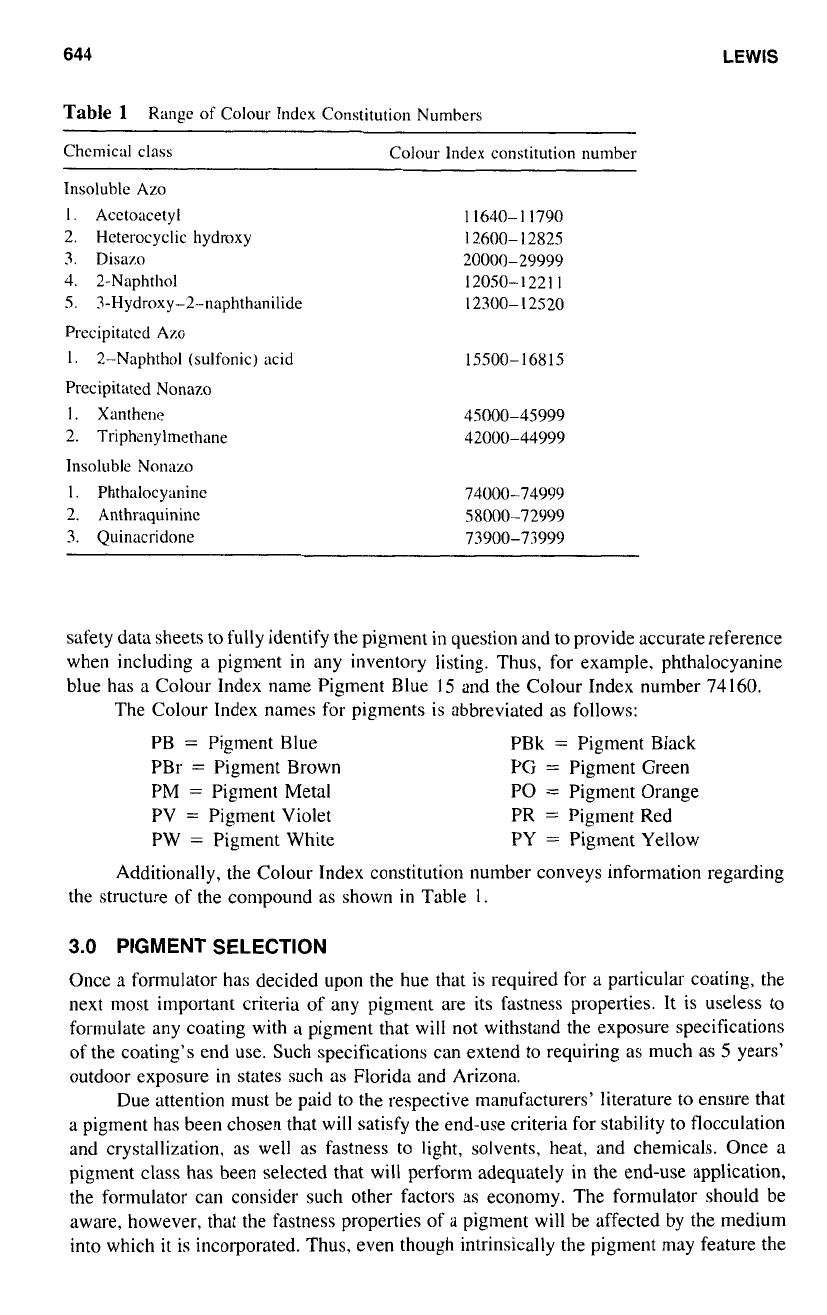
644
LEWIS
Table
1
Range
of
Colour Index Constitution Numbers
Chemical class Colour lndex constitution number
Insoluble Azo
I.
Acetoacetyl
2.
Heterocyclic hydroxy
3.
Disazo
4.
2-Naphthol
S.
3-Hydroxy-2-naphthanilide
Precipitated Azo
I.
2-Naphthol (sulfonic) acid
Precipitated Nonazo
I.
Xanthene
2.
Triphenylmethane
Insoluble
Nonazo
1.
Phthalocyanine
2.
Anthraquininc
3.
Quinacridone
11640-11790
12600- 12825
20000-29999
12050-12211
12300-
I2520
1.5500-16815
45000-45999
42000-44999
74000-74999
58000-72999
73900-73999
safety data sheets to fully identify the pigment in question and to provide accurate reference
when including a pigment
in
any inventory listing. Thus, for example. phthalocyanine
blue has a Colour Index name Pigment Blue
15
and the Colour Index number
74160.
The Colour Index names for pigments is abbreviated as follows:
PB
=
Pigment Blue PBk
=
Pigment Black
PBr
=
Pigment Brown PG
=
Pigment Green
PM
=
Pigment Metal
PO
=
Pigment Orange
PV
=
Pigment Violet
PR
=
Pigment Red
PW
=
Pigment White PY
=
Pigment Yellow
Additionally, the Colour Index constitution number conveys information regarding
the structure of the compound as shown
in
Table
1.
3.0
PIGMENT SELECTION
Once a formulator has decided upon the hue that is required for a particular coating, the
next most important criteria
of
any pigment are its fastness properties. It is useless to
formulate any coating with a pigment that will
not
withstand the exposure specifications
of the coating’s end use. Such specifications can extend to requiring as much as
5
years’
outdoor exposure
in
states such as Florida and Arizona.
Due attention must be paid to the respective manufacturers’ literature
to
ensure that
a pigment has been chosen that will satisfy the end-use criteria for stability
to
flocculation
and crystallization, as well as fastness to light, solvents, heat, and chemicals. Once a
pigment class has been selected that will perform adequately in the end-use application,
the formulator can consider such other factors as economy. The formulator should be
aware, however, that the fastness properties
of
a pigment will be affected by the medium
into which
it
is incorporated. Thus, even though intrinsically the pigment may feature the
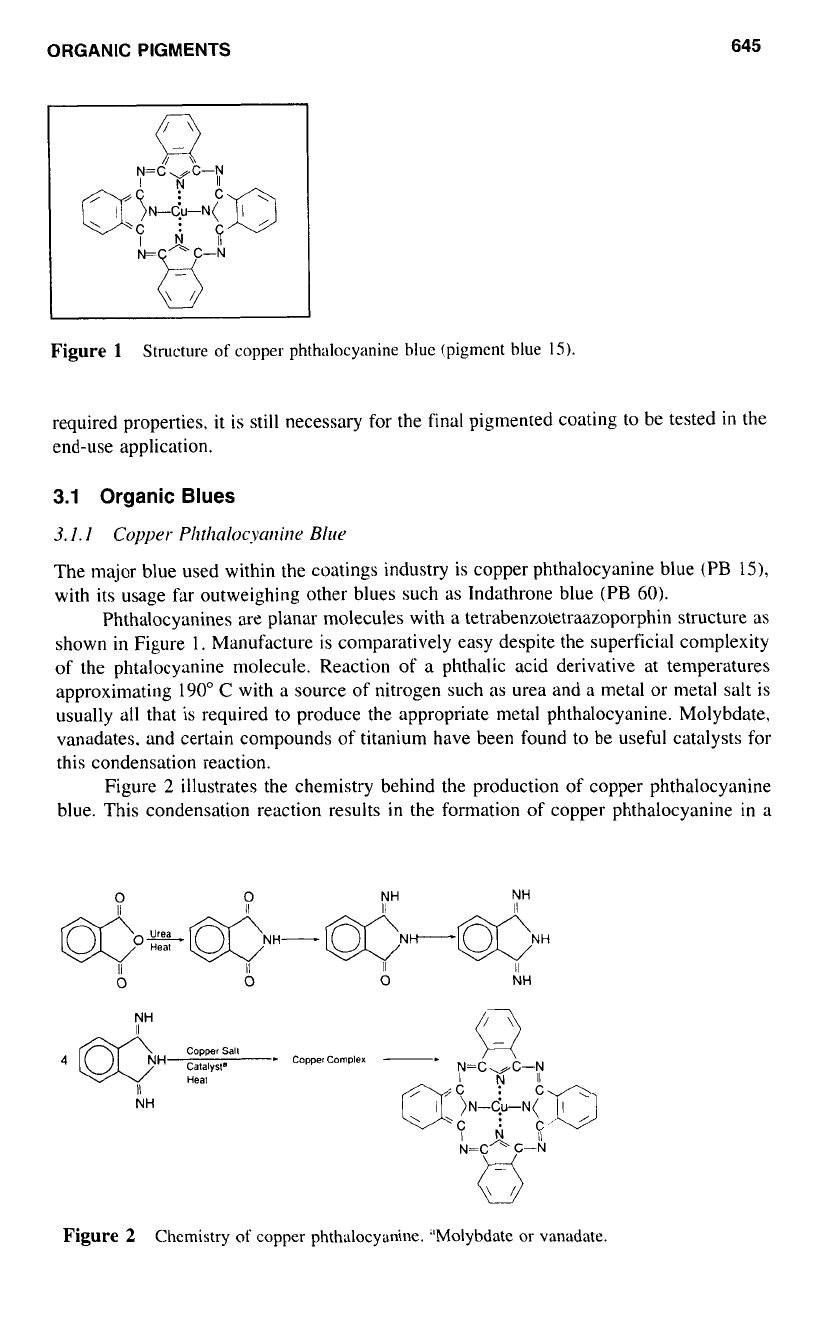
ORGANIC
PIGMENTS
645
Figure
1
Structure
of
copper phthalocyanine bluc (pigment blue
IS).
required properties, it is still necessary for the final pigmented coating to be tested
in
the
end-use application.
3.1
Organic Blues
3.1.
I
Copper
Phtkalac~var~ir~r
Blur
The major blue used within the coatings industry is copper phthalocyanine blue (PB
15),
with its usage far outweighing other blues such as lndathrone blue (PB
60).
Phthalocyanines are planar molecules with a
tetrabenzotetraazoporphin
structure as
shown in Figure
1.
Manufacture is comparatively easy despite the superficial complexity
of
the phtalocyanine molecule. Reaction of a phthalic acid derivative at temperatures
approximating
190" C
with a source
of
nitrogen such
as
urea and a metal or metal salt
is
usually all that is required to produce the appropriate metal phthalocyanine. Molybdate.
vanadates. and certain compounds
of
titanium have been found to be useful catalysts for
this condensation reaction.
Figure
2
illustrates the chemistry behind the production of copper phthalocyanine
blue. This condensation reaction results
in
the formation of copper phthalocyanine
in
a
Figure
2
Chemistry
of
copper phthalocyanine. "Molybdate or vanadate.
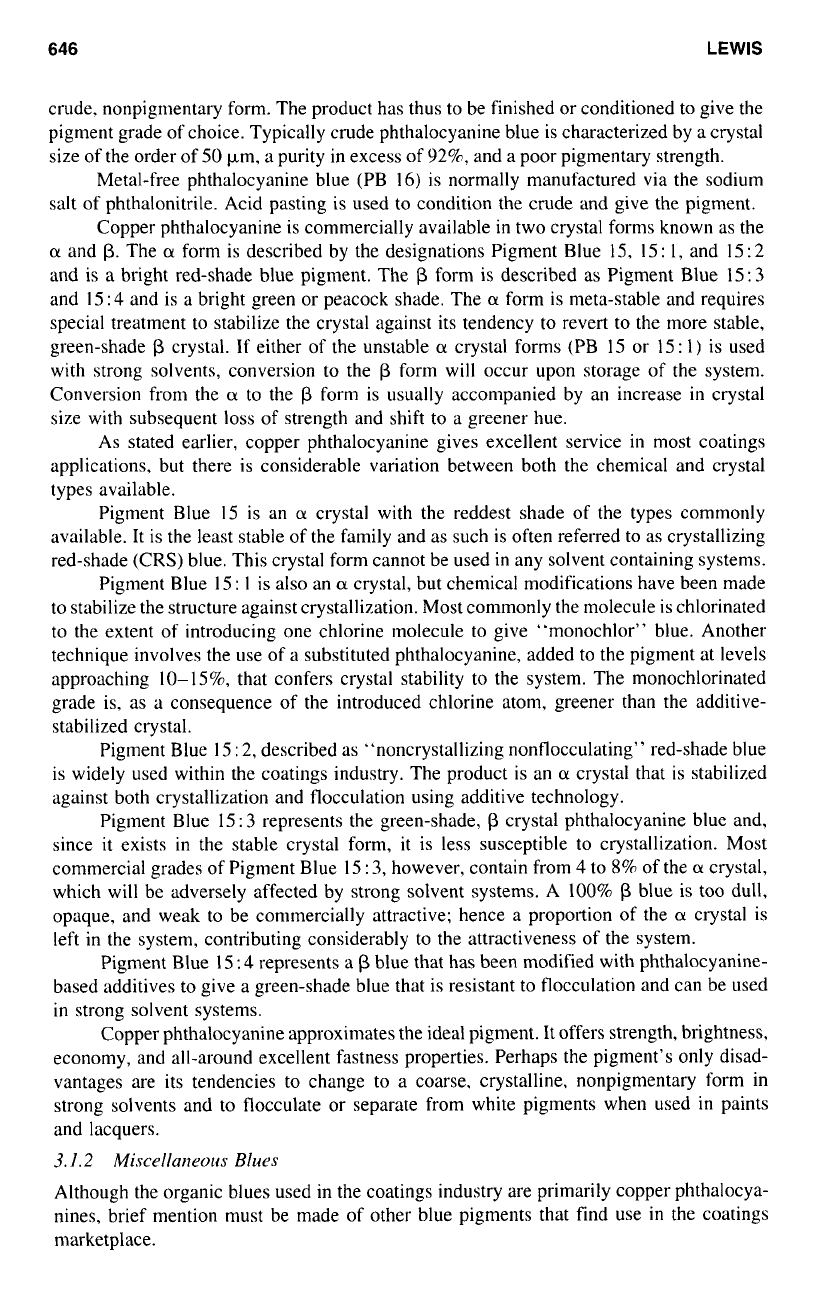
646
LEWIS
crude. nonpigmentary form. The product has thus to be finished or conditioned to give the
pigment grade of choice. Typically crude phthalocyanine blue is characterized by a crystal
size of the order of
50
km, a purity in excess
of
92%,
and
a
poor pigmentary strength.
Metal-free phthalocyanine blue (PB
16)
is normally manufactured via the sodium
salt of phthalonitrile. Acid pasting is used to condition the crude and give the pigment.
Copper phthalocyanine is commercially available
in
two crystal forms known as the
a
and
p.
The
a
form is described by the designations Pigment Blue
15,
15
:
1,
and
15
:
2
and is a bright red-shade blue pigment. The
p
form is described as Pigment Blue
15
:
3
and
15
:
4
and is a bright green or peacock shade. The
a
form is meta-stable and requires
special treatment to stabilize the crystal against its tendency
to
revert
to
the more stable,
green-shade
p
crystal.
If
either of the unstable
a
crystal forms (PB
15
or
15
:
1)
is used
with strong solvents, conversion
to
the
p
form will occur upon storage of the system.
Conversion from the
a
to the
p
form is usually accompanied by an increase
in
crystal
size with subsequent
loss
of strength and shift
to
a greener hue.
As stated earlier, copper phthalocyanine gives excellent service
in
most coatings
applications, but there is considerable variation between both the chemical and crystal
types available.
Pigment Blue
15
is an
(Y
crystal with the reddest shade of the types commonly
available. It is the least stable of the family and as such is often referred to as crystallizing
red-shade (CRS) blue. This crystal form cannot be used
in
any solvent containing systems.
Pigment Blue
15
:
1
is
also
an
a
crystal, but chemical modifications have been made
to stabilize the structure against crystallization. Most commonly the molecule is chlorinated
to the extent of introducing one chlorine molecule to give “monochlor” blue. Another
technique involves the use of a substituted phthalocyanine, added to the pigment at levels
approaching
10-15%,
that confers crystal stability
to
the system. The monochlorinated
grade is, as a consequence
of
the introduced chlorine atom, greener than the additive-
stabilized crystal.
Pigment Blue
15
:
2,
described as “noncrystallizing nonflocculating” red-shade blue
is widely used within the coatings industry. The product is an
(Y
crystal that is stabilized
against both crystallization and flocculation using additive technology.
Pigment Blue
15
:
3
represents the green-shade,
p
crystal phthalocyanine blue and,
since it exists in the stable crystal form,
it
is
less susceptible to crystallization. Most
commercial grades of Pigment Blue
15
:
3,
however, contain from
4
to
8%
of the
a
crystal,
which will be adversely affected by strong solvent systems. A 100%
p
blue is too dull,
opaque, and weak to be commercially attractive; hence a proportion
of
the
a
crystal is
left in the system, contributing considerably to the attractiveness of the system.
Pigment Blue
15
:
4
represents a
p
blue that has been modified with phthalocyanine-
based additives to give a green-shade blue that is resistant to flocculation and can be used
in
strong solvent systems.
Copper phthalocyanine approximates the ideal pigment. It offers strength, brightness,
economy, and all-around excellent fastness properties. Perhaps the pigment’s only disad-
vantages are its tendencies to change
to
a
coarse, crystalline, nonpigmentary form in
strong solvents and to flocculate or separate from white pigments when used
in
paints
and lacquers.
3.1.2
Miscellartrous
Blues
Although the organic blues used in the coatings industry are primarily copper phthalocya-
nines, brief mention must be made of other blue pigments that find use
in
the coatings
marketplace.
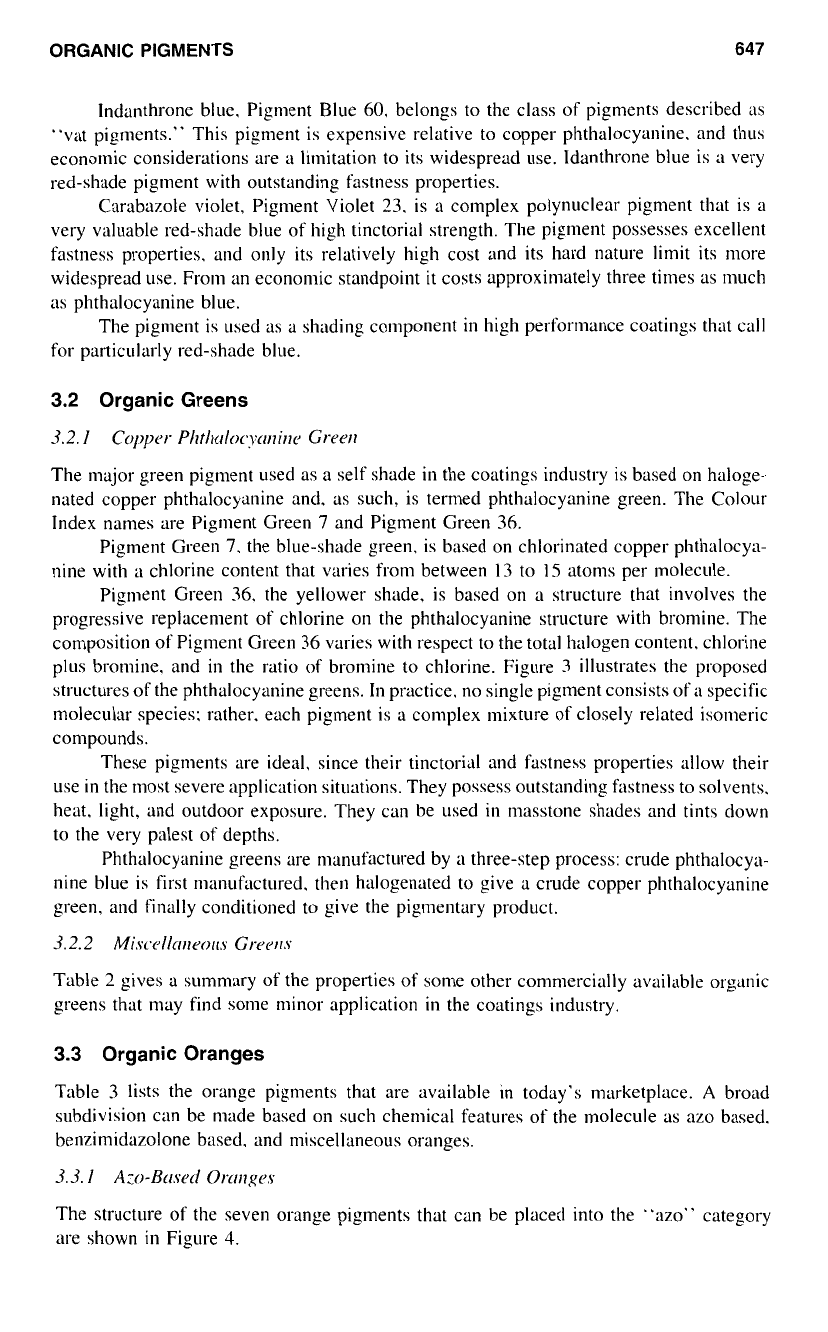
ORGANIC PIGMENTS 647
lndanthrone blue. Pigment Blue 60, belongs
to
the class of pigments described
as
“vat pigments.” This pigment is expensive relative to copper phthalocyanine. and thus
economic considerations are
a
limitation to its widespread use. Idanthrone blue is
a
very
red-shade pigment with outstanding fastness properties.
Carabazole violet, Pigment Violet
23.
is
a
complex polynuclear pigment that is a
very valuable red-shade blue of high tinctorial strength. The pigment possesses excellent
fastness properties. and only its relatively high cost and its hard nature limit its more
widespread use. From an economic standpoint
it
costs approximately three times as much
as
phthalocyanine blue.
The pigment is used as a shading component
in
high performance coatings that call
for particularly red-shade blue.
3.2
Organic Greens
3.2.
l
Copyor
Phthuloc.!:rrnirl~~
Green
The major green pigment used as a self shade
in
the coatings industry is based on haloge-
nated copper phthalocyanine and. as such, is termed phthalocyanine green. The Colour
Index names are Pigment Green
7
and Pigment Green
36.
Pigment Green
7.
the blue-shade green, is based on chlorinated copper phthalocya-
nine with
a
chlorine content that varies from between
13
to
15
atonis per molecule.
Pigment Green 36. the yellower shade, is based on a structure that involves the
progressive replacement of chlorine
on
the phthalocyanine structure with bromine. The
composition
of
Pigment Green 36 varies with respect
to
the total halogen content, chlorine
plus bromine. and
in
the ratio
of
bromine
to
chlorine. Figure 3 illustrates the proposed
structures
of
the phthalocyanine greens.
In
practice. no single pigment consists ofa specific
molecular species; rather. each pigment is a complex mixture of closely related isomeric
compounds.
These pigments are ideal, since their tinctorial and fastness properties allow their
use
in
the most severe application situations. They possess outstanding fastness to solvents.
heat. light, and outdoor exposure. They can be used
in
masstone shades and tints down
to the very palest of depths.
Phthalocyanine greens are manufactured by
a
three-step process: crude phthalocya-
nine blue is first manufactured. then halogenated
to
give
a
crude copper phthalocyanine
green, and finally conditioned
to
give the pigmentary product.
3.2.2
MiscdImeom
Grcw~s
Table
2
gives a summary of the properties
of
some other commercially available organic
greens that may find some minor application
in
the coatings industry.
3.3
Organic Oranges
Table
3
lists the orange pigments that are available
in
today’s marketplace.
A
broad
subdivision can be made based on such chemical features of the molecule
as
azo based.
benzimidazolone based. and miscellaneous oranges.
3.3.
l
A~o-B~I.sP~
Or~Il~t~c~.~
The structure of the seven orange pigments that can be placed into the “azo” category
are shown
in
Figure
4.
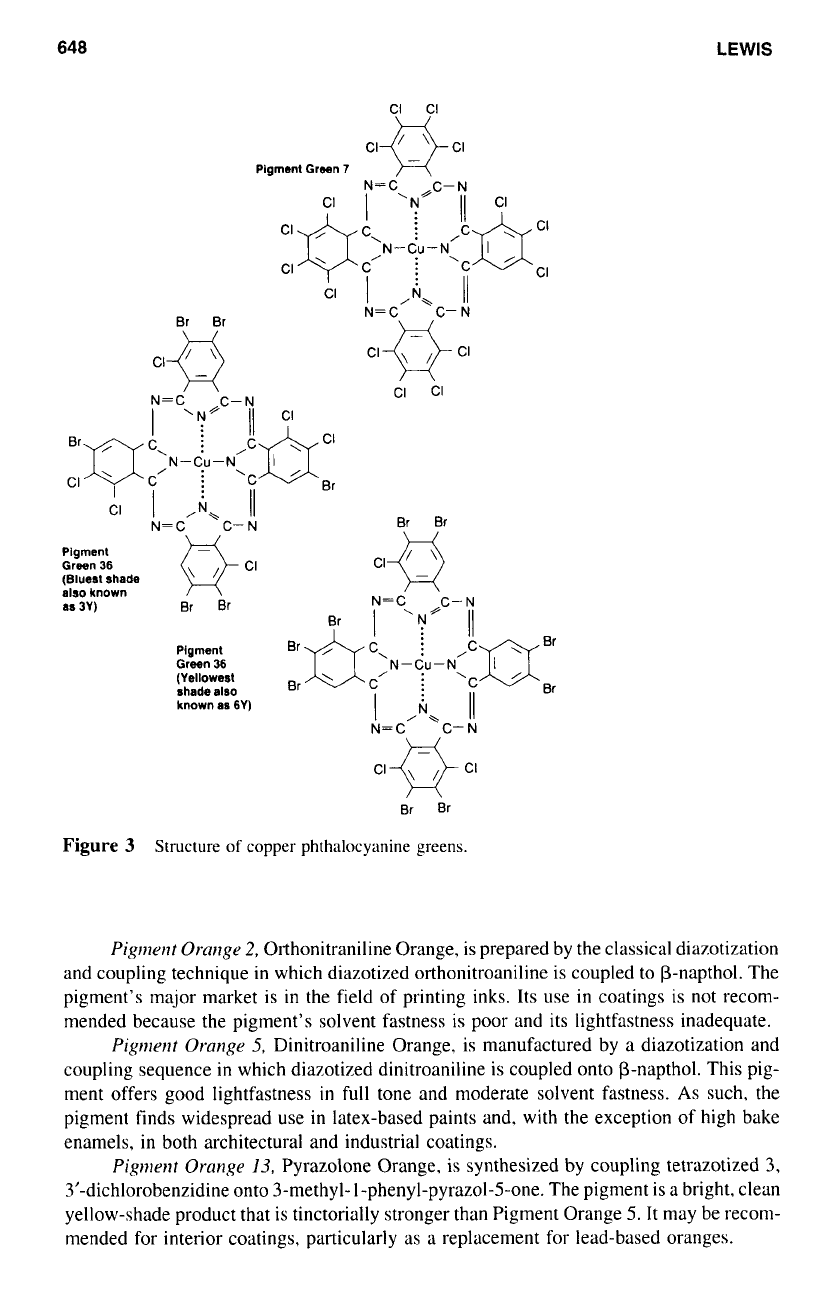
648
LEWIS
Pigment
Green
36
(Bluest shade
also
known
as
3Y)
Br Br
Pigment
Green
36
(Yellowest
ahade
also
known
as
6Y)
Br
Br
Figure
3
Structure
of
copper phthalocyanine greens.
Pigmwf
Orflnge
2,
Orthonitraniline Orange, is prepared by the classical diazotization
and coupling technique in which diazotized orthonitroaniline is coupled to P-napthol. The
pigment's major market is in the field of printing inks. Its use
in
coatings is
not
recom-
mended because the pigment's solvent fastness is poor and its lightfastness inadequate.
Pigmwt
Ormge
5,
Dinitroaniline Orange, is manufactured by a diazotization and
coupling sequence
in
which diazotized dinitroaniline is coupled onto P-napthol. This pig-
ment offers good lightfastness
in
full tone and moderate solvent fastness.
As
such, the
pigment tinds widespread use in latex-based paints and, with the exception of high bake
enamels, in both architectural and industrial coatings.
Pigmrnt
Orange
13,
Pyrazolone Orange,
is
synthesized by coupling tetrazotized
3,
3'-dichlorobenzidine onto
3-methyl-l-phenyl-pyrazol-Sone.
The pigment is a bright, clean
yellow-shade product that is tinctorially stronger than Pigment Orange
5.
It may be reconi-
mended for interior coatings, particularly as a replacement for lead-based oranges.
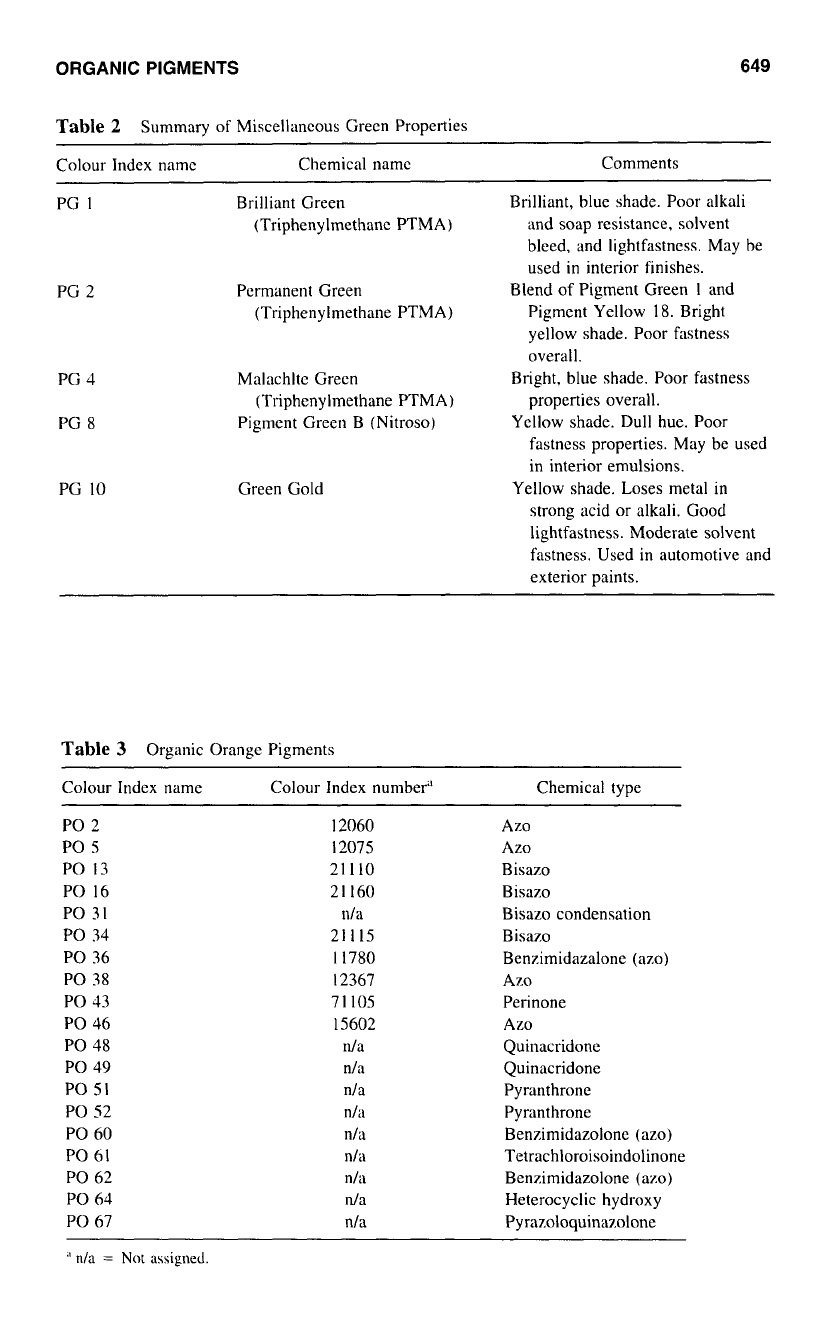
ORGANIC
PIGMENTS 649
Table
2
Summary
of
Miscellaneous Grecn Properties
Colour Index name Chemical name
Comments
~~ ~
PG
1
Brilliant Green Brilliant, blue shade. Poor alkali
(Triphenylmethane PTMA) and soap resistance, solvent
bleed, and lightfastness. May be
used in interior finishes.
PG 2 Permanent Green Blend of Pigment Green
I
and
(Triphenylmethane PTMA) Pigment Yellow 18. Bright
yellow shade. Poor
f.
dstness
overall.
PG
4
Malachltc Green Bright, blue shade. Poor fastness
(Triphenylmethane PTMA) properties overall.
PG 8 Pigment Green B (Nitroso) Yellow shade. Dull hue. Poor
fastness properties. May be used
in interior emulsions.
PG
10
Green Gold Yellow shade. Loses metal in
strong acid or alkali. Good
lightfastness. Moderate solvent
fastness. Used in automotive and
exterior paints.
Table
3
Organic Orange Pigments
Colour Index name Colour Index number'' Chemical type
PO
2
PO
5
PO
13
PO
16
PO
31
PO 34
PO 36
PO
38
PO 43
PO
46
PO 48
PO
49
PO
51
PO 52
PO
60
PO
61
PO 62
PO 64
PO 67
12060
12075
21
I10
21
160
n/a
21
115
I
1780
I2367
71
l05
15602
nla
nla
n/a
nla
n/a
nla
nla
nla
nla
~
Azo
Azo
Bisazo
Bisazo
Bisazo condensation
Bisazo
Benzimidazalone (azo)
Azo
Perinone
Azo
Quinacridone
Quinacridone
Pyranthrone
Pyranthrone
Benzimidazolone (azo)
Tetrachloroisoindolinone
Benaimidazolone
(azo)
Heterocyclic hydroxy
Pyrazoloquinazolone
.'
n/a
=
Not
assigned
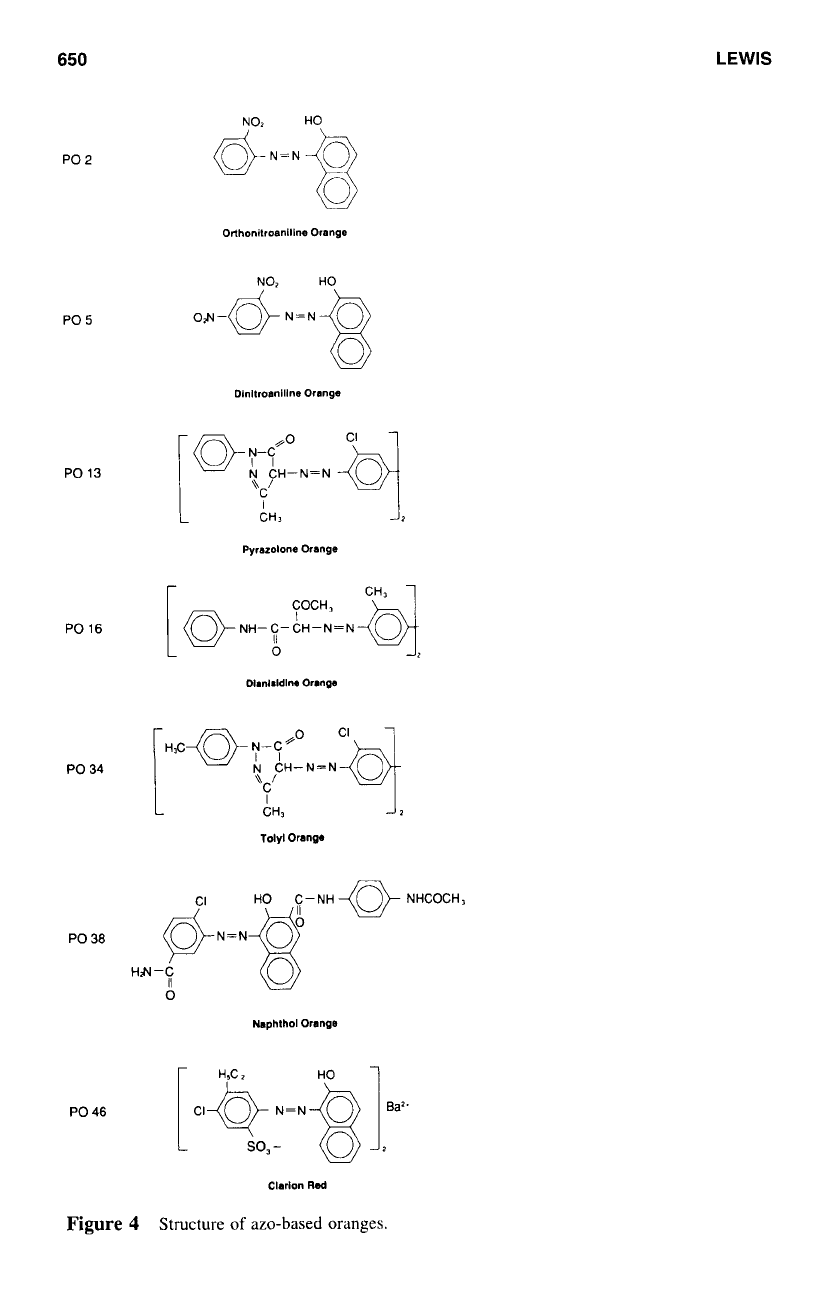
650
LEWIS
PO
2
PO
5
PO
13
PO
16
PO 34
PO 38
PO
46
d-N=NB
Orlhonilroanillne Orange
NO,
H0
ofl-GN=NB
Dlnltroanlllne Orange
L
CH,
J,
Pyrazolone Orange
DImlsldlm Orwnpe
Tolyl
Orange
H0
C-NH
HN
-C
+N=Ng
0
Naphthol Orange
NHCOCH,
U
Clarion
Rad
Figure
4
Structure
of
azo-based
oranges.
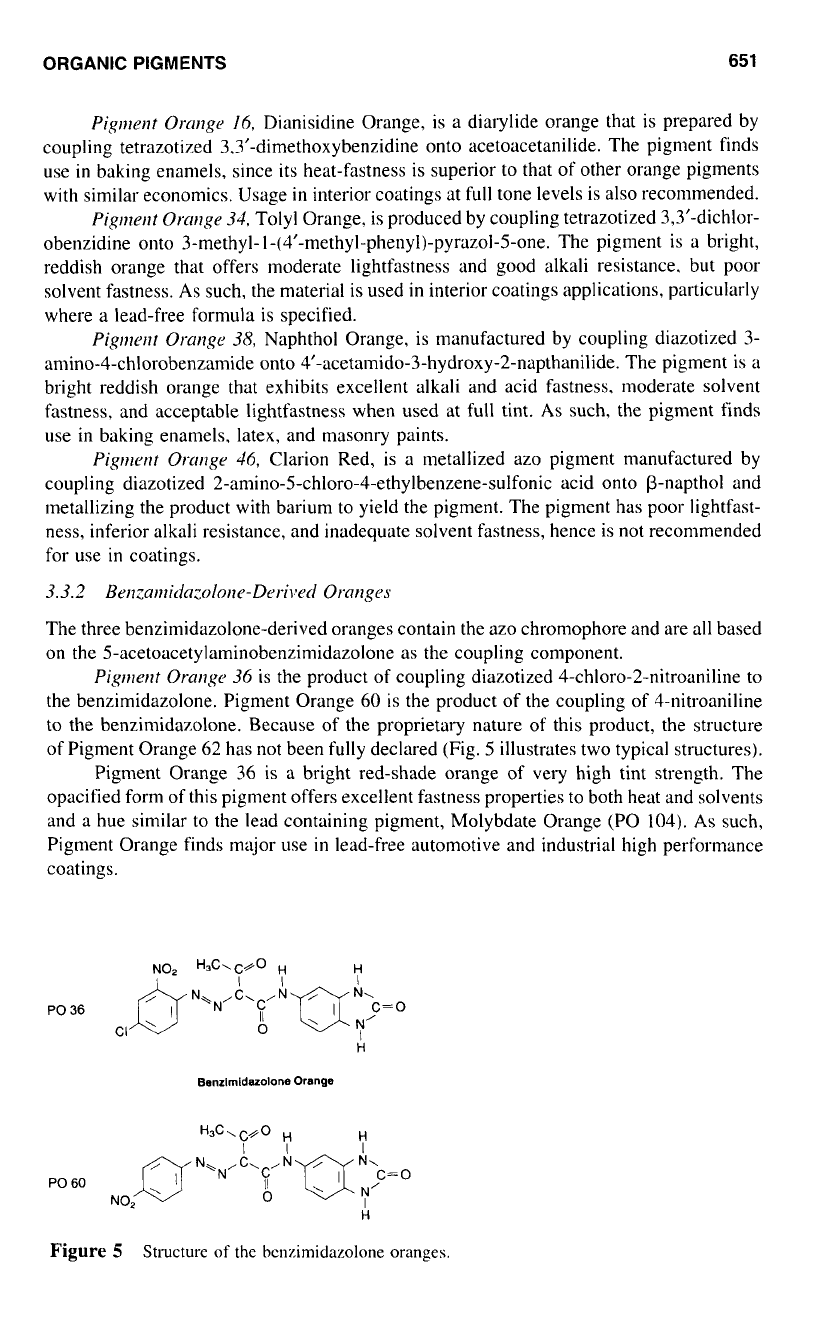
ORGANIC
PIGMENTS
651
Pignlent
Orcrnge
16,
Dianisidine Orange, is a diarylide orange that is prepared by
coupling tetrazotized 3,3’-dimethoxybenzidine onto acetoacetanilide. The pigment finds
use
in
baking enamels, since its heat-fastness is superior to that of other orange pigments
with similar economics. Usage
in
interior coatings at
full
tone levels is also recommended.
Pig~~rlt
Orrrnge
34,
Tolyl Orange. is produced by coupling tetrazotized 3,3’-dichlor-
obenzidine onto 3-methyl-
1
-(4’-methyl-phenyI)-pyrazol-5-one.
The pigment is a bright,
reddish orange that offers moderate lightfastness and good alkali resistance. but poor
solvent fastness.
As
such, the material is used
in
interior coatings applications, particularly
where a lead-free formula is specified.
Pig~ilenr
Orange
38,
Naphthol Orange, is manufactured by coupling diazotized
3-
amino-4-chlorobenzamide onto
4’-acetamido-3-hydroxy-2-napthanilide.
The pigment is
a
bright reddish orange that exhibits excellent alkali and acid fastness. moderate solvent
fastness, and acceptable lightfastness when used at full tint.
As
such, the pigment finds
use in baking enamels, latex, and masonry paints.
Pignwnt
Orcrnge
46,
Clarion Red, is a metallized azo pigment manufactured by
coupling diazotized
2-an~ino-5-chloro-4-ethylbenzene-sulfonic
acid onto P-napthol and
metallizing the product with barium to yield the pigment. The pigment has poor lightfast-
ness, inferior alkali resistance, and inadequate solvent fastness, hence is not recommended
for use
in
coatings.
3.3.2
Berlzarilir~a~:olorl(.-Der-i~~erl
Orange's
The three benzimidazolone-derived oranges contain the azo chromophore and are
all
based
on the
5-acetoacetylaminobenzimidazoIone
as the coupling component.
Pigment
Orarlge
36
is the product of coupling diazotized 4-chloro-2-nitroaniline to
the benzimidazolone. Pigment Orange 60 is the product of the coupling of 4-nitroaniline
to the benzimidazolone. Because of the proprietary nature
of
this product, the structure
of Pigment Orange 62 has not been fully declared (Fig.
5
illustrates two typical structures).
Pigment Orange 36 is a bright red-shade orange of very high tint strength. The
opacified form of this pigment offers excellent fastness properties
to
both heat and solvents
and a hue similar to the lead containing pigment, Molybdate Orange (PO 104).
As
such,
Pigment Orange finds major use
in
lead-free automotive and industrial high performance
coatings.
Benzlrnldazolone
Orange
Figure
5
Structure
of
the bcnzimidazolone oranges.
